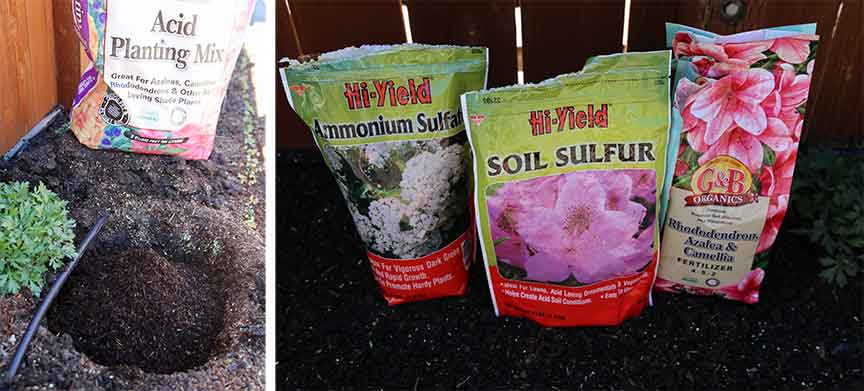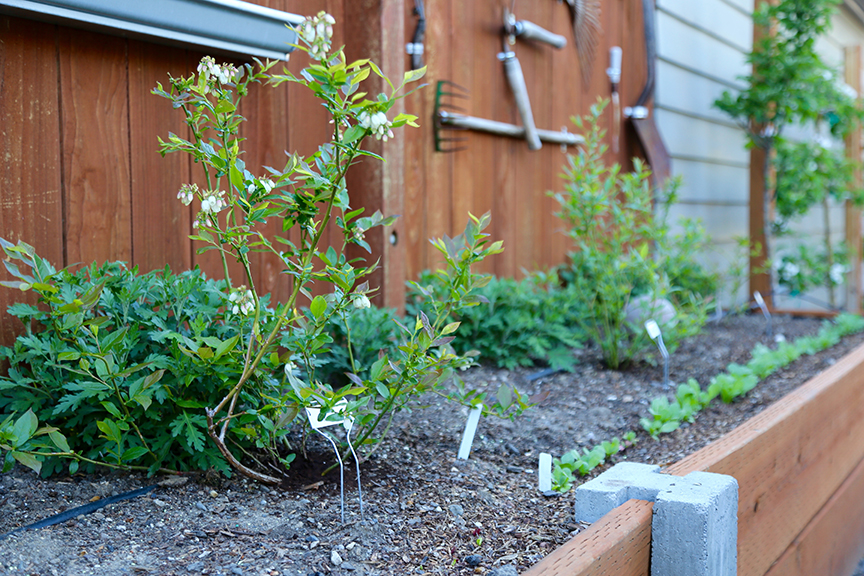I’d tried a couple times to grow blueberries and I’d failed an equal amount of times. Apparently my standard stick-it-in-the-ground-and-let-it-be approach wasn’t going to work this time. Resolved to have blueberries as part of the SNOW Block Alley project, I signed up for the blueberry class at FarWest Garden Center to get schooled on the error of my ways.
There’s a misconception that you can’t grow blueberries in Idaho as blueberries like acidic soil – something we don’t have here. That’s not the case though. You just need to make sure to set yourself up for success right from the get go.
What you’ll need:
If you want to keep things organic, click on the links below to see the products that I use.
• Acid Loving Potting Mix
• Sulfur
• Ammonium Sulphate
• Organic Acid Plant Fertilizer
• Bird netting
Pollinating
Blueberries are self fruiting however they get lonely and need a friend. Ok… that’s not entirely true but you’ll get better yields when you have at least two varieties (not to mention twice as many berries). Here’s where it gets tricky though. Plants come in early, mid or late season bearing. Not only will your plants do better when you have at least two but you need two that share a pollination window. So, for example you could have an early producing plant and a mid season variety, or a mid season and a late season plant. Or two of any of the same fruiting window. What you can’t have is an early and a late. When in doubt, get a mid season variety and you’ll be good to go.
The varieties we have are:
• Chandler – mid to late – world’s largest blueberry
• Bluecrop – mid – leading commercial cultivar
• Duke – early season
• Pink Lemonade – mid to late – and yes, it’s bright pink!
• Toro – mid to late
Picking a location
Another misconception is that blueberries like shade. Go ahead and pick a sunny spot. What they don’t like is wet feet so choose a location where they will get plenty of water (1˝ to 2˝ a week for young plants, 1.5˝ to 3˝ for mature ones) but where the soil has good drainage.
Once you picked your spot dig the hole for your plant. Blueberries have shallow root systems so the hole doesn’t have to as deep as it does wide. This next step is key – backfill with Acid Loving Potting Mix. I know it’s tempting to skip this step but, speaking as someone that’s learned the hard way, don’t. This blend provides the pH level that blueberries like so that you aren’t battling alkaline soil right from the get go. For the ultimate in soil control, blueberries can also be grown in pots.
Fertilization schedule
• St Patrick’s Day – around the middle of March apply 1 cup of sulfur per plant. After the first year, also add 1/4 to 1/2 cup of ammonium sulfate. With a 21-0-0 ratio, embrace a less-is-more approach as the high nitrogen level can burn the plants.
• Memorial Day – apply a second application (1 cup) of sulfur as well as 1/4 to 1/2 cup of organic acid plant fertilizer.
Don’t kill the messenger
You know that beautiful blueberry bush you bought that has blooms all over it? Or maybe it already has fruit developing? I know this is not what you’re going to want to hear, but this first season you need to pluck all of that off. I know, I know but it’s especially important that the plant puts all its energy in developing a healthy root system and it can’t do that if it’s making fruit so as painful as it is, you gotta do it. Console yourself by thinking how much better those blueberries will taste next summer.
For the birds
So now it’s your second summer with your blueberry plants and guess who likes blueberries as much as you do? Yep… the birds. Consider covering your plants with bird netting well before the berries ripen (no guarantees this will help with the squirrels though).
So yes, blueberries might be a little more work on the uptake but spend a little extra time on the front end laying the right foundation and you’ll be reaping the benefits for years to come.




Thank you for this.
You are so welcome!
I picked 32 lbs of blue bell blue berries this morning in Emmet Idaho. The bushes were loaded with the biggest berries I have ever seen. I asked the Grower what the variety was and they said blue bell. Will I need a second variety planted near them?
Hi Tracie and thanks for your message. That’s an amazing haul of blueberries you got! How cool is that? I’m not familiar with the Blue Bell variety, and whether they need a pollinator, but that’s something your nursery should be able to answer. I bought all the blueberries in the alley at FarWest and I love those guys. They are super knowledgable and in the spring they have a great series of classes, including one on growing blueberries (which I’ve taken twice!). Good luck!
Thank you so much for this! I’ll be taking that class at FarWest!
The class is awesome! Enjoy!
I live in Portland, Oregon and have about 25 plants that are well over 50 years old. My husband wants to move us to Idaho and I want to take five or six of my plants with me. I’m thinking Northern Idaho, where it gets really cold. Do you have any advice on how to do this and what to do once we get there?
Hi Gaylene and thanks for writing. There’s a couple things to take into consideration here. First, you’re trying to move mature plants. Second, the climate is VERY different in Northern Idaho even from Southern Idaho. Down in the south we stay much warmer in the winter and don’t see nearly the amount of snow. Finally, I’m guessing because I bought my plants from a local nursery, they were plant stock meant for my zone and could be different than what you have in Oregon. I would find a nursery either locally in Oregon, or better yet, at your new destination, and talk to them about it. If you know the varieties you have I’m sure that would be important information to share with them. Thanks and have a great day.
Thank you. I have no idea the varieties of my plants. I’m having a hard time thinking about giving up my home of 43 years, but the acre and a half is getting to be too much for me. I will see what I can find out here. Thanks so much for the quick reply.
Gaylene,
Did you move to north Idaho and did you move some blueberries with you. How did they do and any recommendations you would have.
I bought some blueberry bushes from a farm in Oregon and I live in North Idaho, now I’m second guessing myself.
Hi Valorie,
No, haven’t moved. I figure it’ll be a few more years if it ever even happens. Several of my bushes were nearly obliterated a year ago January when the neighbor’s gigantic Pin oak fell over onto my patch. They got zero attention last year because of the mess, and then we had a super hot summer so they didn’t hardly produce at all, but this year they’re looking fantastic! I had them pruned down, worked the dirt around them, and fertilized them. Having a hard time finding sawdust, though, but I think they’re going to do well this year. I’m very interested in keeping in the loop about how your Oregon bushes do.